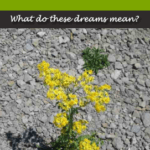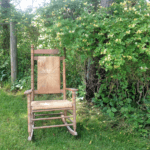Dream Interpretation: Dreaming About Eagles
This Beautiful Symbol of America Usually Means “Patriotism”
I recently heard from a young high school student who had experienced an unusual dream. He had seen an eagle in his dream and, in fact, this beautiful bird was the only thing he could remember from the whole dream.
He said that this was fairly unusual because he’d never even seen an eagle in person and certainly hadn’t thought much about eagles, if ever.
Given the fact that he was an American – living in “H-O-T” Texas, as he put it! – I told him that the eagle symbolized America, Patriotism, and Freedom. I asked if any of these had been on his mind lately and he said they had been. He talked a little bit about world events and said that he hated when people didn’t respect their country.
Amen!
Even when non-Americans dream about eagles, the symbolism is freedom and grandness.
Ch- Ch- Ch- Changes at Dream Prophesy!
Plus a Dream Guide You’ll Want to Grab ASAP
As you can see, I’ve changed the look of Dream Prophesy. I wanted to make it easier for you to read and navigate – I hope you like the changes as much as I do!
I’ve also added a new page dedicated to the Dream Guide you see pictured to the right: The Meaning of My Dreams. The page will tell you more about this guide, including…
- Why you’ll want to grab a copy right away.
- The free gift you get when you do order right away!
Finally, I want to thank my regular visitors for being so loyal over the years. You honor me with each and every visit and I can’t thank you enough.
As always, I wish you the sweetest of dreams!
Joi
P.S. Be sure to read about this really cool dream guide today.
Dream Dictionary: What Do Flower Dreams Mean?
A “Lovely” Dream Prophecy from a Symbol of Beauty
Many dream experts believe that a flower dream’s meaning depends upon the type of flower in the dream. While there are extenuating circumstances where the type of flower carries a lot of weight, I believe that flower dreams can pretty much ALL be dealt with similarly, regardless of the type of flower it is. Besides, a lot of people don’t know a Daffodil from a Lily!
Personally, I believe that the color of the flower or flowers is of greater significance, but we’ll get to those in a minute.
Like most things, flowers have a lot of different meanings to a lot of different people. They’re symbolic of everything from romance to funerals. We give/receive flowers when we’re in love, when someone is sick, when congratulations are in order, when someone has a baby, when someone has died, when someone has moved into a new home, and to celebrate special occasions such as Valentine’s Day or Mother’s Day.
Flowers essentially represent the following:
- Beauty
- Emotion
- An attempt to make things better
Think about it, when we give flowers, we’re letting someone know that we care. We’re attempting to bring beauty into their lives with one of the most universal symbols of beauty: Flowers.
In dreams, if we are giving flowers to another person, it is symbolic of our desire to make something better for someone or to at least let them know we care. We may have done something that we’re seeking forgiveness for or we may simply want to show our love. Only the dreamer will know for certain when it comes to the motivation.
If we receive flowers in the dream, almost always the interpretation is the same: We are looking for love, concern, and for someone to acknowledge us in some way. Many people who feel under-appreciated and taken for granted will dream of receiving flowers.
If the flowers are flowers you associate with funerals or death (usually carnations or black flowers in dreams), the dream interpretation is that you are gravely concerned for someone’s health – possibly even your own. On the other hand, if they’re flowers you’d associate with a newborn baby (usually pink and/or pale blue), you have babies on the brain! Interestingly enough, this could even symbolize kittens or puppies. They’re babies, after all!
If the flowers in the dream indicate a wedding to you (Calla Lilies, white roses, baby’s breath…), the interpretation is that you are either, literally, thinking of a wedding, or you are contemplating a commitment of some sort.
The first things to ask yourself about the flowers in your dream are:
- What do I associate these flowers with? (gardening, love, sickness, funerals, beauty, Valentine’s Day, weddings)
- How did the flowers make me feel in the dream? (comforted, happy, sad, loved)
- What colors do I remember most about the flowers? (pink, red, blue, black, white, yellow, purple…)
The answers to these questions will lead you to your own personal interpretation of your dream.
A few Dream Symbolisms from Flower Dreams:
- Black flowers indicate depression, sadness, disappointment, and even death. Dreams are not prophetic, so don’t jump off the deep end when you read the word death! This simply indicates that death has been on your mind fairly recently – whether you’ve been thinking about your own life, someone who you are worried about, or someone you’ve already lost.
- Blue flowers generally represent something soothing, but they can also be symbolic for a male.
- Red can be symbolic of several emotions. The dreamer must look at how it’s used in the context of the dream (in other words, how did you FEEL in the dream when you saw the red flowers). Red usually symbolizes love, romance, and passion – but it can also represent anger and jealousy.
- Pink usually means romance, flirtation, or girls. However, it can also be symbolic for breasts – breast health, breast cancer, and breasts in general!
- Purple flowers stand for great success – royal success even. If you have purple flowers in your dream, you have success on your mind. You may have also recently achieved something that you feel very proud of.
- Gold, Silver, and Bronze flowers symbolize celebrations. Whether it’s weddings, anniversaries, or other milestones, flowers in these colors mean that you’ve recently had something of great importance on your mind and/or in your life.
- Yellow and/or orange flowers indicate pure joy, cheerfulness, and happiness. Generally when people dream of yellow or orange flowers, it indicates a clear conscience as well as a great mood.
- White flowers usually represent honesty, purity, and love. However, they can also represent a desire to CLEAN something or even someone! White is a highly complex color when it comes to dreams, so you really have to rely on how you felt at the time of the dream.
- Green is generally considered to be symbolic of jealousy or envy. If you dream of green flowers, you may have recently dealt with one of these common emotions.
Dream Journals and Dream Symbols
I always, always, always recommend that my readers keep a dream journal.
Dream analysis is utterly fascinating and the best way to get ALL you can from the experience is to keep a dream journal. Even if the dream seems unspectacular and commonplace, you should write down the details.
For example, in your dream journal you should include the following information:
- How you felt during the dream.
- How you felt when you first awoke.
- Who was in the dream with you.
- The predominant colors in your dream.
- Any dream symbols you recall
- The date
- VERY IMPORTANT: Include a few words about how you felt during the day. I’ll tell you why in a minute.
You don’t have to go into great, lengthy details in your dream journal (unless you want to, of course!). You can simply write down a series of words and names. Just remember to include HOW you felt during and after the dream. You don’t even HAVE to have an actual dream journal, you could most definitely use an old notebook! However, don’t use random loose sheets of paper. Why? They’ll inevitably get lost and unorganized. What you’re looking for is a pattern. You need to see what dream symbols you frequently dream about and what people show up often in your dreams.
You also want to watch for situations or emotions that recur in your dreams. Do you often lose things in your dreams (a sign that you feel overwhelmed)? Are you often mistreated in your dreams (a sign that you feel like a victim)? So, as you can see, it will greatly benefit you to have your dreams chronicled in a very organized and ordered manner.
Why What’s Happening in Your Life at the Time Matters
You want to include what’s going on in your life at the time of the dream. For example, if you’re feeling stressed at work, write it down! You’ll be able to see what sort of dream symbols and situations occur when you’re dealing with stress in your life. Also… and this is pretty cool…. you’ll often find out exactly WHAT or WHO is causing you the most stress! If you have recurring “frustration” dreams and a certain co-worker consistenly shows up in them, he or she is a source of your stress and frustration. It could be one small thing they do (or fail to do) that irritates you or it could be every single thing about them! On the other hand, the stress could possibly come from the fact you don’t know how to handle or deal with them. Only you will know for sure.
The thing is, the dream journal and your entries in it will give you a great place to start looking for the root of your stress.
Emotions we feel during the day impact our dreams like nothing else. If we experience FEAR during a movie, for example, we’ll probably face it again in an upcoming dream. That’s why we always say, “I dread my dreams tonight!” after seeing horror movies. We know all too well the fear factor will rear its ugly head again!
The same is true with other emotions. If we feel angry or annoyed, something will probably happen in our dreams that angers or annoys us. It’s as though our dream tries to sort out the strong emotions by “acting out” similar scenarios. Also, if we’re feeling particularly close to someone, we may have dreams that are very pleasant, positive, and even romantic.
This is why it’s so important to jot down a few words about how you’re feeling in “the real world” at the time of the dreams.
I hope you’ll strongly consider keeping a dream journal. The benefits are amazing and, trust me, you’ll have a really fun time!
The Bedside Dream Journal: A Nighttime Memory Book, shown at the top of the post, is an excellent dream journal. It’s available on Amazon for just a little over $10.
Fascinating Q & A With Dream Expert and Author Robert Moss
 Robert Moss is the creator of Active Dreaming, an original method of dreamwork and healing through the imagination. Born in Australia, he survived three near-death experiences in childhood. He leads popular seminars all over the world, including a three-year training for teachers of Active Dreaming and a lively online dream school. A former lecturer in ancient history at the Australian National University, he is a bestselling novelist, journalist, and independent scholar. His seven books on dreaming, shamanism and imagination include Conscious Dreaming, Dreamways of the Iroquois, The Three “Only” Things, The Secret History of Dreaming, and Dreamgates: Exploring the Worlds of Soul, Imagination, and Life Beyond Death.
Robert Moss is the creator of Active Dreaming, an original method of dreamwork and healing through the imagination. Born in Australia, he survived three near-death experiences in childhood. He leads popular seminars all over the world, including a three-year training for teachers of Active Dreaming and a lively online dream school. A former lecturer in ancient history at the Australian National University, he is a bestselling novelist, journalist, and independent scholar. His seven books on dreaming, shamanism and imagination include Conscious Dreaming, Dreamways of the Iroquois, The Three “Only” Things, The Secret History of Dreaming, and Dreamgates: Exploring the Worlds of Soul, Imagination, and Life Beyond Death.
Moss’s Active Dreaming is an original synthesis of contemporary dreamwork and shamanic methods of journeying and healing. A central premise of Moss’s approach is that dreaming isn’t just what happens during sleep; dreaming is waking up to sources of guidance, healing and creativity beyond the reach of the everyday mind. He introduced his method to an international audience as an invited presenter at the conference of the International Association for the Study of Dreams at the University of Leiden in 1994.
Over the past fifteen years, he has led seminars at the Esalen Institute, Kripalu, the Omega Institute, the New York Open Center, Bastyr University, John F. Kennedy University, Meriter Hospital, and many other centers and institutions. He has taught in-depth workshops in Active Dreaming in the UK, Australia, Canada, Costa Rica, France, the Netherlands, Denmark, Lithuania, Romania, and Austria and leads a three-year training course for teachers of Active Dreaming. He leads popular online dreamwork courses at www.spirituality-health.com, writes the “Dream Life” column for Spirituality magazine, and hosts the Way of the Dreamer radio show at www.healthylife.net.
He has appeared on many TV and radio shows, ranging from Charlie Rose and the Today show to Coast to Coast, and including The Diane Rehm Show on NPR, Michael Krasny’s Forum on KQED San Francisco, The Faith Middleton Show on Connecticut Public Radio, and CBC’s Tapestry program. His articles on dreaming have been published in media ranging from Parade to Shaman’s Drum and Beliefnet.com.
His books have been published in more than twenty foreign languages.
Below, we can get into Robert’s mind and learn more about dreams and his newest book, The Secret History of Dreaming.
You are a former history professor and you say that to research and write this book you had to become a “dream archeologist”. What is “dream archeology” and what skills and resources are required to practice it?
While “archeology” is often understood to be the science of unearthing and studying antiquities, the root meaning is more profound: it is the study of the arche, the first and essential things. The practice of “dream archeology” requires mastery of a panoply of sources, and the ability to read between the lines and make connections that have gone unnoticed by specialists who were looking for something else. It requires the ability to locate dreaming in its context – physical, social and cultural. And it demands the ability to enter a different time or culture, through the exercise of active imagination, and experience it from the inside as it may have been. These are the skills we need to excavate the inner dimension of the human adventure.
What is the most important thing you can tell us about your new book, The Secret History of Dreaming?
The Secret History of Dreaming restores a missing dimension to our understanding of what drives the human adventure: the vital role of dreams and imagination in science and literature, war and religion, medicine and the survival of our kind. History without the inner side is as shallow as history without economics, and as boring as history without sex.
This is not another book about dreams. It is a history of dreaming, a term I use in an expansive sense to encompass not only night dreams but also waking visions, the interplay of mind and matter that is sometimes called synchronicity, and experiences in a creative “solution state”.
Explain your statement that a dream led directly to one of the biggest oil discoveries in world history.
In 1937, Colonel Harold Dickson, the former British Political Agent in Kuwait, dreamed that a sandstorm opened a crater under a strange tree in the desert, and revealed a mummy that came to life as a beautiful woman who gave him an ancient coin. His wife recorded the dream for him in the middle of the night, and then he consulted a Bedouin woman dream interpreter who gave him the location of the tree in his dream – in the Burqan hills – and told him he would find great treasure there. He was able to persuaded the Kuwait Oil Company (which had been drilling dry holes up to this point) and they struck it rich at the exact place he had dreamed. This was the origin of Kuwait’s oil wealth and a major source for the Allies in World War II.
Tell us about the dreams of the Founding Fathers
John Adams and Dr Benjamin Rush – who made a close study of precognitive dreams – were in the habit of exchanging dreams in their extensive correspondence. In 1809, Rush wrote to Adams about a dream in which the doctor’s son read him a page from the future history of the United States. The dream letter described “the renewal of friendship” between Adams and Thomas
Jefferson, who had been estranged for many years because of their political disagreements. It
stated that the later correspondence of the two former presidents would inspire many. And it recorded that Adams and Jefferson “sunk into the grave nearly at the same time.” Nearly seventeen years later, long after their reconciliation, the two former presidents died on the same day – July 4, 1826. The predictions on the page of Dr Rush’s dream history were exactly fulfilled.
Explain how Harriet Tubman’s dreams and visions helped her to guide escaping slaves to freedom on the Underground Railroad.
Harriet Tubman is an iconic figure in American history – the runaway slave from Maryland’s Eastern Shore who went back to the South, braving great dangers, to free her fellow-slaves and became the most successful “conductor” of the Underground Railroad. Yet the secret of Harriet Tubman’s achievement has rarely been told. She was a dreamer and a seer. In her dreams and visions, she could fly like a bird. Her gift may have been associated with a near-death experience in her childhood, when an angry overseer threw a two-pound lead weight that laid open her skull. We learn from her how great gifts can spring from our wounds. Harriet herself said she inherited special gifts – including the ability to travel outside the body and to visit the future – from her father, who “could always predict the future” In The Secret History of Dreaming, I examine the evidence that her ancestors were Ashanti, and that she may have inherited something of the Ashanti experience of dream tracking. I also look at the influence of the first, fiercely brave and inspiring, itinerant black women preachers, whose example may have helped Harriet develop the power to transfer her vision. She could sing courage into people’s hearts.
Tell us how Freud, tragically, may have missed an early dream diagnosis of the mouth cancer that killed him many years later.
The most famous of all the dreams Freud analyzed was one of his own, the Irma Dream. In The Interpretation of Dreams he gives a lengthy account of this 1895 dream and his work with it. In the dream, he inspects the mouth of a patient called Irma and discusses her condition with several doctors. The tragic irony is that in all his work on this dream, Freud may have missed a health warning that could have saved his life. I report on the exhaustive work of a cancer surgeon who compared Freud’s medical records with his dream report and concluded that the contained an amazingly exact preview of precise symptoms of the oral cancer that killed Freud 28 years later.
You write: “Because young Sam Clemens could not find Brazil, he failed to become the first cocaine dealer in North America and instead became Mark Twain.” Tell us that story!
While he was working as a printer in Keokuk, Iowa, young Sam Clemens read a book that described “a vegetable product with miraculous powers” that was growing in Brazil. Sam was “fired with a longing” to go up the Amazon, secure a supply of this miracle plant – and make a fortune. He sailed to New Orleans on a riverboat whose pilot was the celebrated Horace Bixby.
When he got to New Orleans, Sam found that no ship in port was sailing for Brazil and no one could tell him how to get there. So he changed his plans, sought out Bixby, and persuaded him to take him on as an apprentice pilot. Working on the Mississippi river, he got many of the ideas for the books that made him famous under a pen-name borrowed from the boatmen’s cry “Mark Twain”, meaning two fathoms, safe water.
The miracle plant Sam had set out to find was coca. Had he succeeded in his original plan, Keokuk, Iowa would have become the cocaine capital of America. Because Sam Clemens couldn’t find Brazil, he failed to become the first cocaine dealer in North American history and instead became Mark Twain.
Tell us about the mystery of the Chinese Woman in Wolfgang Pauli’s dreams that Jung could not figure out.
The quantum physicist Wolfgang Pauli frequently dreamed of an alluring “Chinese woman” who moved like a snake dancer. Though he found her sexy, she sometimes appeared in situations that filled him with dread, as if his world was being shaken. He was also distressed by a dream in which the Chinese woman had a baby the world would not acknowledge. Paul discussed these dreams with Jung, and Jung talked of archetypes and the anima. Then Pauli’s “Chinese woman” stepped out of his dream life and into the world at the center of the so-called “Chinese revolution” in physics. A woman physicist, Dr Wu, conducted the critical experiments that overthrew one of the scientific paradigms (the parity principle) that Pauli had fiercely upheld, shaking his intellectual universe. Yet when a Nobel prize was awarded for this breakthrough in 1957, only the two theoretical physicists – both men – were recognized; the Chinese woman’s baby went unacknowledged by the world.
I explore this episode in my investigation of the rich 25-year correspondence between Jung and Pauli. They were giants in their respective fields – depth psychology and physics – who goaded each other, in a 25-year intellectual friendship, to step beyond the boundaries of their disciplines and seek to develop a working model of a universe in which mind and matter are constantly interweaving. But they were capable of missing dream clues!
Tell us about the woman you call “the beautiful dream spy of Madrid.”
Ah, the lovely Lucrecia de Leon! When she was a guest of the Spanish Inquisition, one of the investigators told her, “You are so beautiful a dead man would rise up and make you pregnant.” Since women are absent from so much of the history written by men, it is remarkable that – thanks in part to the Spanish Inquisition – the record of no fewer than 415 dreams of a young woman of Madrid have survived from the time of the Spanish Armada. They were transcribed between 1587 and 1590, by clerics who listened to her accounts of her night adventures while an armed courier waited in the street ready to gallop to the holy city of Toledo to carry the latest dream installment to the head of the powerful Mendoza clan, second only to the Habsburgs in Spain. The reason Lucrecia’s dreams were so prized was that she had a gift for seeing the future and discovering what was going on behind closed doors, in the royal palace or the house of Sir Francis Drake in England. Her dreams were exploited as sources of military intelligence and as political propaganda, in a time when dream visions were still greatly respected. Some of them were painted; others were performed as theatre for high society in the town house of a dowager duchess who may also have been an English agent. Lucrecia’s story is a fascinating chapter in the history of women as well as the history of dreaming.
You are the creator of an original approach to dreamwork and healing that you call Active Dreaming. What is Active Dreaming? Will you give us examples of original techniques you have developed, and tell us how they differ from other approaches to dream interpretation or analysis?
Active Dreaming is founded on the understanding that dreaming isn’t just what happens during sleep; dreaming is waking up to sources of guidance, healing and creativity beyond the reach of the everyday mind.
One of the most important original techniques I have introduced is the Lightning Dreamwork Game, a fast and fun way to share inner experiences, get helpful feedback and guidance for action that you can practice with just about anyone, almost anywhere, It’s a great inner workout, and when you play it with friends or family or workmates, you’ll find you are deepening and energizing your relationships. By simply playing the game, you’ll find you can recognize and work with diagnostic and precognitive elements in dreams, and harvest personal imagery for healing and creative projects.
I teach many techniques for conscious dream travel. This goes far beyond what “lucid dreaming” is commonly thought to be. We learn to start out lucid and stay lucid. Using shamanic techniques for shifting consciousness, we embark on intentional journeys – often with partners or a whole group – on agreed itineraries, which might take us on a mission to scout out the possible future, or explore an alternate reality or a location in the imaginal realm, or through the doorway of a previous dream or vision. We learn to travel back inside dreams to dialogue with dream characters, resolve nightmare terrors, bring through healing and guidance, and scout out the possible future.
I love leading games of coincidence and imagination, and am constantly dreaming up new ones. Active dreamers find that the world around us will speak to us in the manner of dreams if we will only pay attention. I teach people how to navigate by synchronicity, how to harvest personal imagery for healing, and how to grow a vision so deep and strong that it wants to take root in the world.
About the Author
Robert Moss was born in Australia, and his fascination with the dreamworld began in his childhood, when he had three near-death experiences and first learned the ways of a traditional dreaming people through his friendship with Aborigines. A former professor of ancient history, he is also a novelist, journalist, and independent scholar.
I’ll write my review of this outstanding book later this week – it is definitely one you’ll want to read.








RECENT COMMENTS AND SHARED DREAMS